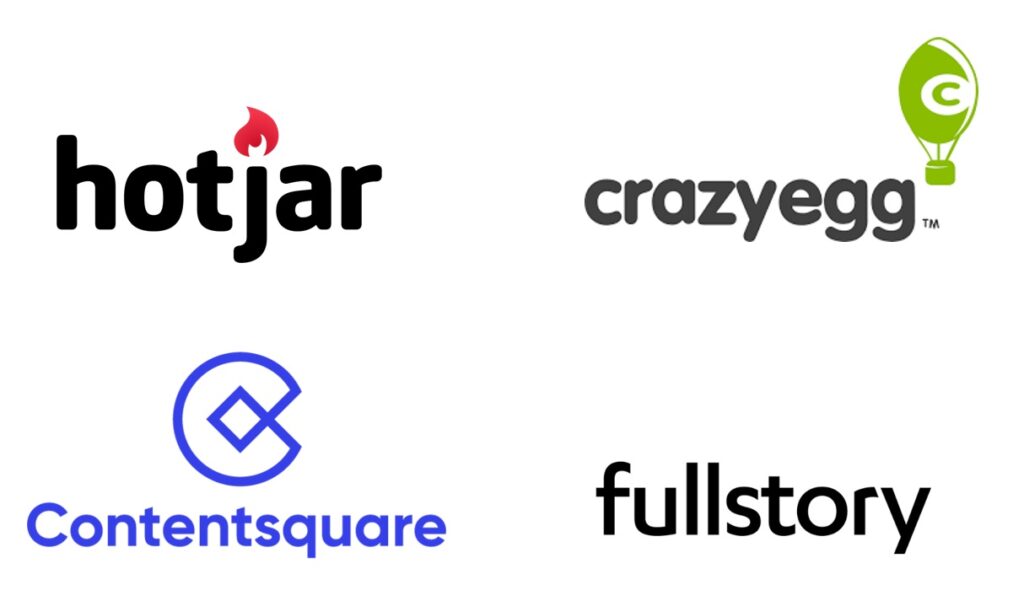
In the competitive landscape of digital experience optimization, understanding and analyzing user behavior is paramount. Contentsquare, Hotjar, Crazy Egg, and FullStory are prominent players in the field, each offering a suite of tools to help businesses gain valuable insights into how users interact with their websites. In this detailed comparison, we will delve into the differences between these four platforms, exploring their features, strengths, and use cases.
Differences between ContentSquare vs HotJar vs CrazyEgg vs FullStory
Contentsquare
1. Emphasis on Customer Journey Mapping
Contentsquare stands out for its comprehensive approach to mapping the entire customer journey. It provides a holistic view of user interactions from the initial landing page to the final conversion or exit. This emphasis on the entire journey allows businesses to identify pain points and areas for improvement across multiple touchpoints.
2. AI-Driven Insights
Utilizing artificial intelligence, Contentsquare goes beyond basic analytics. It employs machine learning algorithms to provide intelligent insights into user behavior, allowing businesses to uncover trends and patterns more effectively. This AI-driven approach enhances the depth and accuracy of the analysis.
3. Visual Analytics
Contentsquare excels in visual representation. Its visual analytics tools include heatmaps, session replays, and more, offering a user-friendly interface for interpreting complex data. The visual aspect simplifies the identification of user engagement patterns and areas that require attention.
Hotjar
1. All-in-One Solution
Hotjar distinguishes itself by offering a comprehensive suite of tools, including heatmaps, session recordings, surveys, and feedback forms. This all-in-one approach makes it a versatile solution for businesses looking to gather diverse insights into user behavior.
2. Affordability
Hotjar is often lauded for its cost-effectiveness, making it an attractive option for small to medium-sized businesses. The platform provides powerful analytics without imposing a significant financial burden, making it accessible to a broad range of organizations.
3. Feedback Collection
One of Hotjar’s notable features is its emphasis on feedback collection. The platform allows businesses to gather insights directly from users through polls, surveys, and feedback forms. This real-time feedback is valuable for understanding user sentiment and preferences.
Crazy Egg
1. Heatmap Customization
Crazy Egg is renowned for its advanced heatmap customization capabilities. Users can focus on specific elements such as clicks, scrolls, and user attention, providing a granular view of user interactions. This level of customization enables businesses to pinpoint areas of interest with precision.
2. A/B Testing
With robust A/B testing capabilities, Crazy Egg empowers businesses to experiment with different website elements. This feature allows for data-driven decision-making by testing variations and understanding which elements resonate best with the audience, ultimately optimizing the user experience.
3. User Insights
Crazy Egg goes beyond traditional analytics by providing insights into user behavior through features like user recordings. This feature helps businesses understand the ‘why’ behind user interactions, adding a qualitative dimension to the data analysis.
FullStory
1. Session Playback
FullStory is distinguished by its detailed session playback feature. Users can watch recordings of individual user sessions, gaining a comprehensive understanding of how users navigate and interact with the website. This deep dive into user sessions is invaluable for identifying pain points and areas of improvement.
2. Searchable User Data
FullStory sets itself apart with its robust search functionality. Users can search through vast amounts of data to find specific sessions, user behaviors, or trends. This searchability streamlines the process of identifying and addressing specific issues, enhancing the efficiency of the optimization process.
3. Integrations
FullStory offers seamless integrations with various third-party tools, enhancing its compatibility with existing workflows. This flexibility makes FullStory a versatile choice for businesses with diverse tech stacks, allowing for a more integrated and cohesive analytics ecosystem.
In conclusion, Contentsquare, Hotjar, Crazy Egg, and FullStory are powerful tools for user experience analytics, each with its unique strengths. The choice between them depends on the specific needs, priorities, and budget constraints of your business. Contentsquare excels in customer journey mapping and AI-driven insights, Hotjar offers an affordable all-in-one solution with a focus on feedback, Crazy Egg stands out in heatmap customization and A/B testing, while FullStory distinguishes itself with detailed session playback and robust search functionality. To make an informed decision, businesses should carefully evaluate these features in alignment with their objectives for optimizing user experience and achieving digital success.
Frustration Scoring and Signals in Content Square and FullStory
Contentsquare employs advanced analytics and artificial intelligence to identify and quantify user frustration. It provides metrics and insights that help businesses understand where users may be encountering difficulties or experiencing frustration on their websites.
- Error Detection: Contentsquare detects and analyzes error messages and issues users may encounter during their interactions with the website. This includes form validation errors, broken links, or any other factors contributing to user frustration.
- Engagement Metrics: Contentsquare offers engagement metrics, such as time spent on pages, click rates, and navigation patterns. Deviations from typical user behavior can indicate potential sources of frustration.
FullStory is known for its detailed session playback and robust search capabilities. While it may not have a specific “frustration score” feature, users can identify frustration signals through various means:
- Rage Clicks and Error Clicks: FullStory allows users to identify “rage clicks” and “error clicks.” Rage clicks occur when users repeatedly click on an element, indicating frustration. Error clicks are clicks on non-clickable elements, suggesting confusion or frustration.
- Searchable User Data: FullStory’s powerful search functionality enables users to search for specific terms, events, or interactions. This can be useful for identifying patterns related to frustrated user behavior.
-
Error Tracking: FullStory helps in tracking JavaScript errors and console logs, providing insights into technical issues that might contribute to user frustration.
Users can leverage these platforms to gain actionable insights into improving the user experience and reducing frustration on their websites. It’s advisable to check the latest features and updates from the respective platforms for any changes or enhancements related to frustration scoring.











